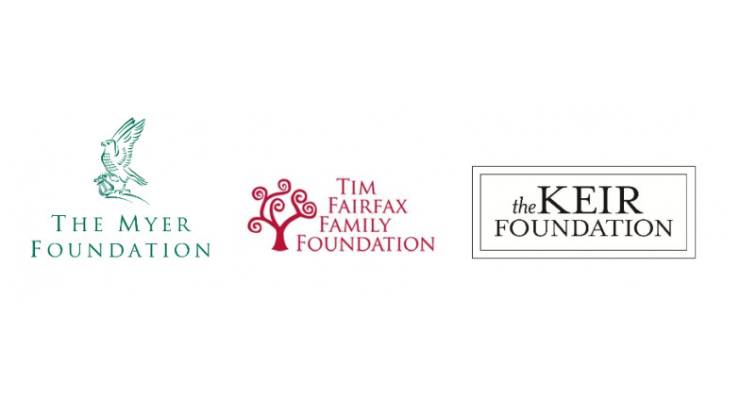
On Saturday, there was an advertisement from three of Australia’s wealthiest benefactors tucked away in the weekend newspapers. Entitled “A New Approach for Australia’s Cultural Sector”, the notice called for submissions for a new think tank for the arts and culture.
“Australia lacks a public, expert, independent voice championing investment and return in arts and culture. Defending and promoting the benefit of intellectual and creative life as a critical crucible of the national future is proving to be increasingly difficult. Australia needs an informed independent entity which has the necessary resources and public authority to advance a coherent, comprehensive policy position from which we might build better political and institutional settings and allied public commentary.”
The advertisement piqued plenty of interest in the always-gossipy arts industry.
For those reading between the lines, the notice appears to be an oblique criticism of the Australia Council’s ability to defend itself, which was so graphically demonstrated during the Brandis funding cuts of last year.
The think tank will be funded by three of Australia’s best-known cultural donors: the Myer Foundation, the Keir Foundation and the Tim Fairfax Family Foundation.
There are all sorts of delicious coincidences. The titular head of the Myer family is, of course, Rupert Myer, the chair of the board of the Australia Council. Myer was conspicuously silent as the Australia Council’s chair while the funding cuts were rammed through last year.
Myer has not commented on the new think tank this week, but few in the sector doubt that the new body bears his imprimatur. In an interview with The Australian’s Matt Westwood, Myer Foundation boss Leonard Vary explained that “our concern is that decisions with respect to arts and culture are being made — it feels sometimes — in the absence of an overarching, clear policy across funding bodies and more generally.”
The new body appears to be intended to have a licence to get involved in public debates about cultural policy. It would presumably issue reports and conduct research highlighting the value of arts funding — always a controversial issue.
The strong early rumour in the industry is that the think tank money will be given to the Grattan Institute, where a new culture program could sit alongside the Grattan’s existing work in climate, education and the like. The Myer Foundation already supports the Grattan with donations, and Grattan boss John Daley is connected to the Australia Council through its research committee. Always hungry for research dollars, many universities are also expected to apply.
Arts industry insiders that Crikey spoke to were enthusiastic about the proposal, but also wary of what a new think tank might signify. Several insiders warned that a “coherent, comprehensive policy position” might be hard to arrive at, while one questioned whether an entity funded by wealthy philanthropists may turn out to be truly independent.
Cynics have also been joking that evidence-based policy doesn’t seem to interest politicians in any other aspect of government, so why should it make a difference in culture?
The intervention by the Myer, Keir and Tim Fairfax foundations also raises some interesting questions about the role of private wealth in Australian culture. Big-name donors are already hugely influential with large cultural institutions behind the scenes. But they are neither elected nor representative of the broader cultural sector, which numerically is made up mostly of solo artists and practitioners with very low incomes.
But the small-scale cultural sector is getting organised, too.
In late November, the activists and agitators responsible for last year’s surprisingly effective Free the Arts campaign gathered in Melbourne, for the latest version of their evolving cultural agenda. The get-together was named ArtsFront 2030, and Crikey went along.
Held at Footscray Community Arts Centre in Melbourne, ArtsFront 2030 was billed as an opportunity for “artists standing up and taking the lead on setting the national policy agenda.” In truth, the conference was really a kind of giant activism workshop for a sector looking to get political in the wake of the bruising funding cuts delivered by George Brandis in 2015.
Participation from indigenous artists was particularly strong, and in many ways the conference turned into a three-day debate on white colonialism. indigenous culture appears to be muscling into previously white spaces in Australian culture in a way we haven’t seen for many years. Just to take two examples, one of the most important albums in Australian contemporary music this year is from indigenous hip-hop outfit A.B. Original, while one of the year’s most talked about shows has been Nakkiah Lui’s Blaque Showgirls.
In an industry when the dominant topic of conversation is often government funding, it was fascinating to see indigenous artists take the lead in organising. The strident language sometimes encountered at ArtsFront 2030 was just a little disconcerting to a number of white participants. But it also shows that the grass-roots of the Australian cultural sector is finally starting to mobilise. The cultural sector has shown relatively little interest in working with social movements like unions and environment groups in recent years, but many at the conference appeared keen for that to change.
One concrete achievement already seems to have emerged: indigenous leaders, including a large group of Aboriginal and Torres Strait Islander artists from around the country, appear to be going ahead with the creation of national council for indigenous artists, with an overtly political agenda. The proposed name for the body is the National Indigenous Arts Council of Australia, or NIACA.
In the long run, a strong, bottom-up voice for indigenous culture in Australia could turn out to be even more important than a new think tank for policy.








Not to mention the relatively new Arts Party was active at last Federal election. Would be interesting to know more about them.
The motives of those involved in such a think tank are pure. They are all (including those at Grattan) massive arts advocates who realise that the only way forward for the arts in Australia is through a strong voice independent of Government (for some, many burnt fingers later …) . This would be the trajectory. It is indeed good to see that groups such as A. B. Original – so smart and so strong – are also impacting. It was disappointing that the Arts Party did not respond with any immediacy to the ABC cuts at Radio National, so one wonders about their cohesion and motivation. We need an umbrella organisation that brings together and links all those advocating for the arts. I thought perhaps The Arts Party could be that org. but they are not. They are just potential pollies! I suspect that Myer/Grattan/Fairfax/Keir have the kind of grunt that is required. Let’s hope so. Thanks for your writing which is always thought-provoking and enjoyable.